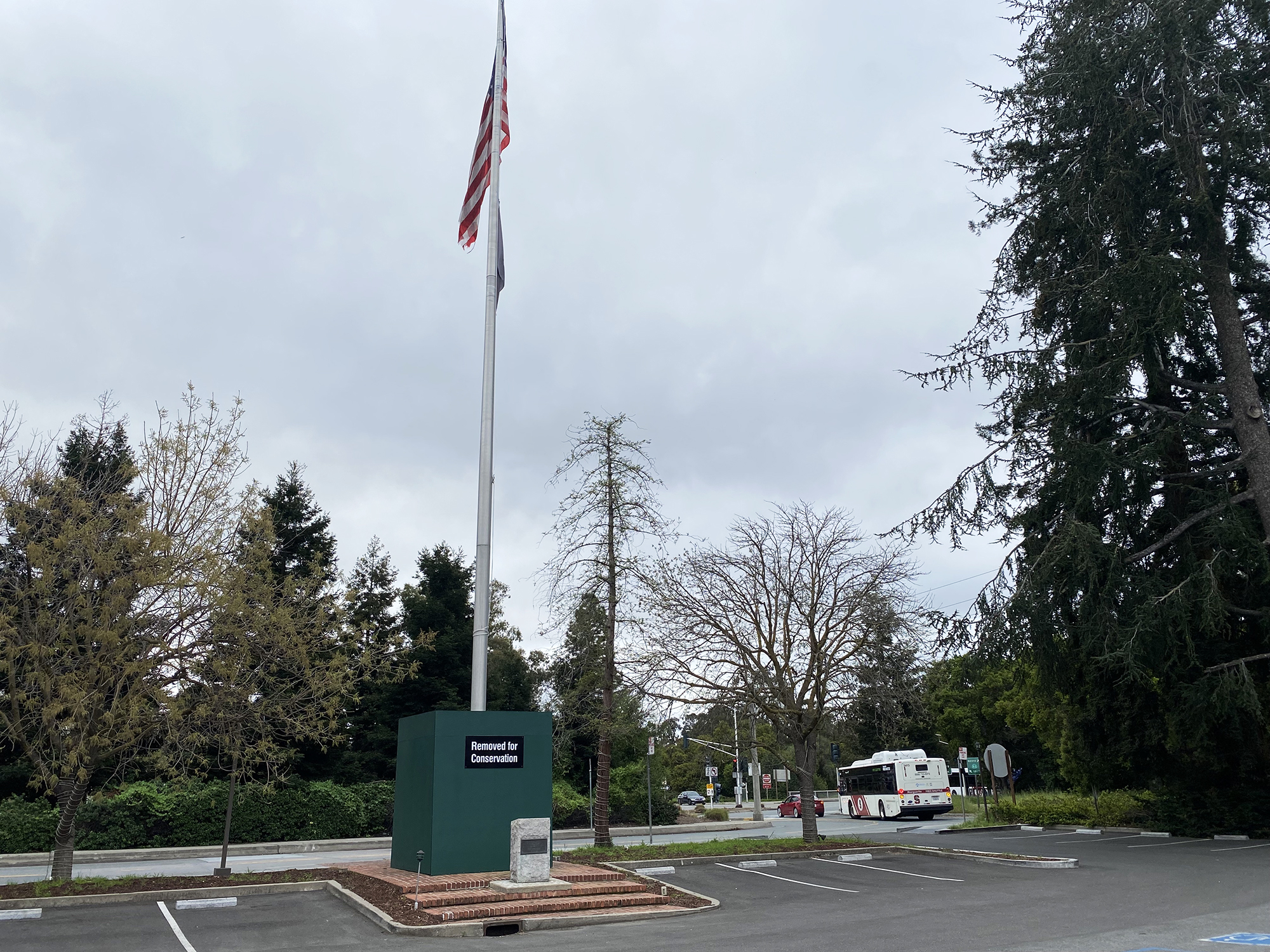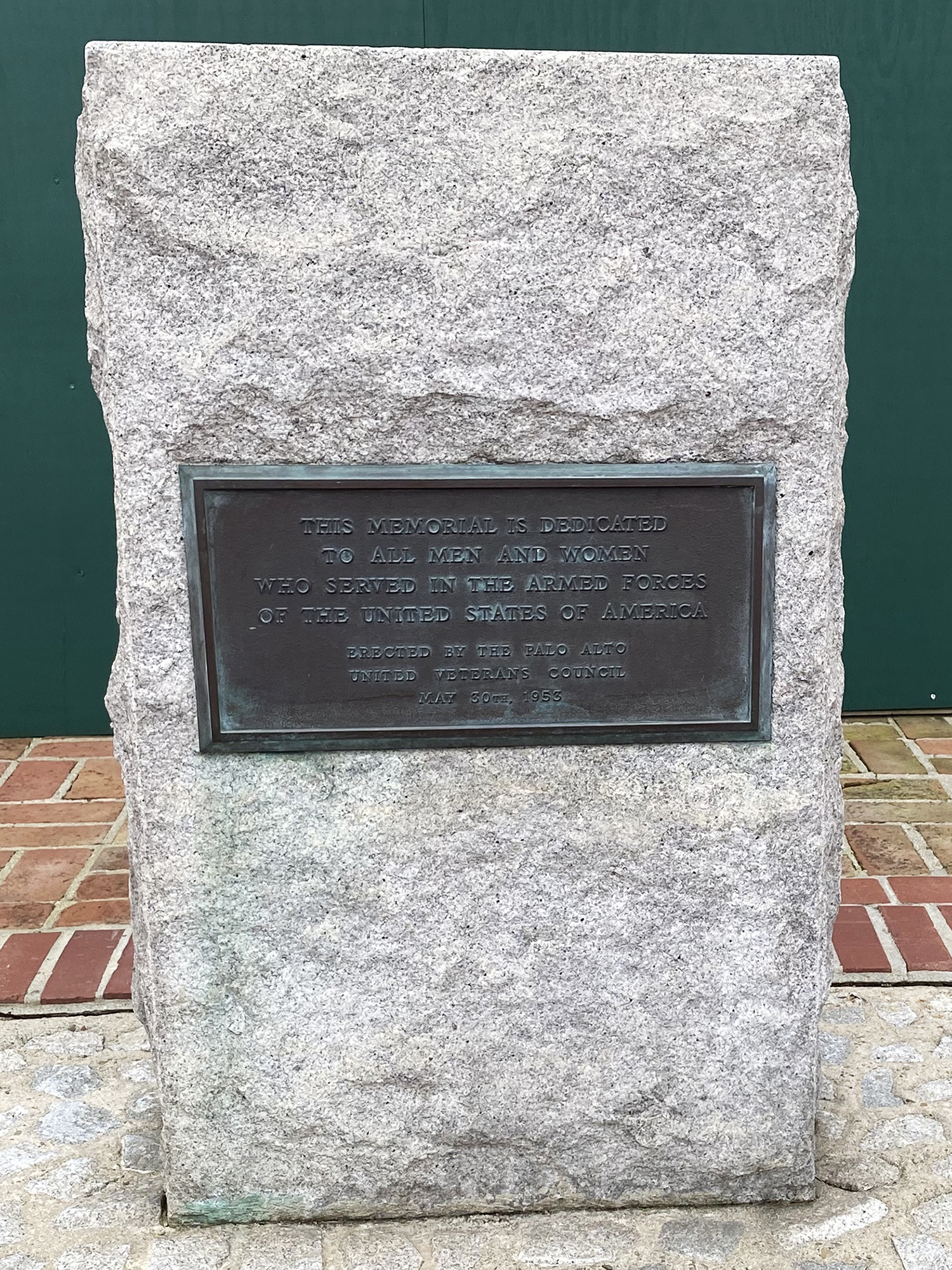Palo Alto's civic leaders, business owners and veteran groups assembled on University Circle on an October day in 1907 for a monumental celebration: the dedication of a 206-foot-tall flagpole in downtown's most prominent location.
Though it wasn't the city's first flagpole, it was by far the largest and most ornate, with a plinth featuring copper plaques commemorating the four organizations that had raised money to install the new fixture: California Pioneers of Santa Clara County, Native Sons of the Golden West, Native Daughters of the Golden West and Veterans of Civil War. Photos compiled by researchers from the American Legion and by historians from Stanford University show crowds gathering under the flag for celebration ceremonies and cadets marching past the flag in 1918, after the United States joined the first World War.
The memorial flagpole remained a fixture at this site for the next three decades, as the United States went through two world wars, before University Avenue was lowered under El Camino Real. Then in March 1941, it was moved to its present location in front of the Veteran's Memorial Building, which was once a gathering place for soldiers and their families and which is now occupied by the MacArthur Park restaurant.
Time, however, has not been kind to the memorial flagpole. In 2021, vandals reportedly damaged the copper plaques at its base. Stanford University, which owns the site and which had leased it to the city for much of the 20th century, responded by removing the plaques and placing a green box around the base of the pole.
Time also has not been kind to one of the flagpole's primary sponsors. The Native Sons of the Golden West, a fraternal organization that is dedicated to creating and protecting national monuments, has faced increased scrutiny in recent years for its racist policy positions during World War II, including its strong advocacy for placing Japanese residents into internment camps.
These factors have created a dilemma for Palo Alto, Stanford University and American Legion, which has been maintaining the flagpole site for decades. For months, officials have been debating two questions: How should a valuable monument be protected from desecration? And what is the best way to honor the flagpole's history without ignoring the racist chapters in the city's and the nation's legacy?
These questions came to the forefront on Thursday, April 13, when the American Legion and Stanford University made their respective cases to the city's Historic Resources Board. Both sides expressed a desire to preserve the historic resources. But while the veterans group believes the plaques should be restored and reinstalled at the downtown location as soon as possible, Stanford has expressed concern that doing so could make them vulnerable to further damage.
While the site has changed dramatically since its early days and now stands out as Palo Alto's primary transit hub, Ray Powell, vice commander at American Legion 375, underscored that its historical status continues to resonate with local veterans.
"It is very important to those veterans who remain that we have some sense of belonging and community and integrity about us and that the community continues to value us," Powell told the board on Thursday. "To see our final monuments disappear would be very heartbreaking for the veterans of Palo Alto."
The plaques, Powell noted, commemorated town founders, veterans and sponsors of the flagpole. The fact that some of these sponsors had views that today are widely viewed as unacceptable does not negate the significance of the monument, he suggested.
"We understand the complicated history of some of those founders, but want to remember that there was a sense of civic and national pride around those," Powell said.
The American Legion also took issue with the way that Stanford handled the vandalism: namely, its decisions not to report the crime to law enforcement and to place a box over the base of the flag.
Post 375 Commander William von Kaenel, whose group has extensively researched the history of the flagpole, suggested in their report the boxing of the base represents a cover-up. He cited in his letter the various schemes that Stanford and the city had considered in recent years to redevelop the site at 27 University Ave., including an ill-fated effort a decade ago to build office towers and a theater and more recent talks about adding housing to the transit-friendly area right next to the downtown Caltrain station and the city's primary bus node.
He and others in the local American Legion post noted that the Veterans Memorial Building, also known as Hostess House, is listed on the National Register of Historic Places and suggested that Stanford sees local and national preservation measures as barriers to its broader goal to redevelop the site and build housing.
"In Post 375's view, the reduction of Historic Preservation to a barrier and impediment to the State-prioritized good of housing is an invitation for officials to extend the push and pull of development levers past conventional boundaries," von Kaenel's report states.
Stanford officials, meanwhile, maintained that the university acted in good faith when it covered up the base of the flagpole in 2021. Stanford University historian Laura Jones noted Thursday that at the time of the vandalism, MacArthur Park Restaurant was closed because of pandemic restrictions and Caltrain ridership had plummeted. With very few people walking through the site, university officials decided that the structure was at risk of further vandalism.
"When the plinth was vandalized, we had it boxed to prevent further removal of the copper," Jones said. "We removed the plaques so that they could be seen."
While they are now no longer displayed at the flagpole, Jones noted that the plaques are now accessible in a way that they wouldn't have been if they were behind the plywood.
"We didn't remove them to censor them. … We removed them to store them appropriately and have access to them," Jones said.
Jones said Stanford has been considering ways to restore the flagpole in a way that is consistent with treatment of historic resources. One is restoring the original American Legion flagpole, which was installed in 1920 at the Hostess House site and that later made way for the memorial flagpole. Another, which is favored by the veterans, is to repair the memorial flagpole sponsored by the four organizations, including Native Sons of the Golden West.
The Historic Resources Board, while acknowledging the fraternal organization's checkered past, strongly endorsed the second option. Board member Michael Makinen, a military veteran, fully backed the American Legion's position and urged Stanford to restore the flagpole, which he said "represents a real significant emotional connection with our veteran organizations."
"It represents a disrespect of our veterans by not having that flagpole and the plinth restored to the condition it was in," Makinen said. "It's very imperative that we do the right thing — restore the flagpole and the plinth."
Other board members largely agreed and suggested that history should be openly displayed and debated, even if it includes chapters that people find offensive. Board member Gogo Heinrich noted that the fact that the organizations raised money for the flagpole showed "great patriotism."
"It would be good for everyone to know that this organization was good and bad," Heinrich said. "But you can't erase history, and I don't think we should be doing that."
Board chair Carolyn Willis agreed and said it's important for Palo Alto and Stanford to "not bury our history." She also noted that there is nothing overtly offensive in the plaques themselves, each of which features the name of a sponsoring organization and its members.
"If people do the research and find out the history of that organization and they object, at least they've learned something and we can understand that we made progress and we need to make more progress," she said.
The board did not take any votes on the item, but members urged Stanford to collaborate with the veteran groups to reach a mutually acceptable solution. Jones agreed and said that decisions on the future of the site, which is critically important to Stanford, Palo Alto and the local veteran community, should be determined in a "collaborative way."
"I think it's really important to acknowledge that our shared past in Stanford and Palo Alto include racist and harmful practices in the past, as well as patriotism, honor and service that is represented by this building and the flagpole," Jones said.




Comments
Registered user
Another Mountain View Neighborhood
on Apr 15, 2023 at 7:24 am
Registered user
on Apr 15, 2023 at 7:24 am
In the 1940’s, the Japanese allied with Hitler and decided to bomb the United States. America’s response was aggressive. We can learn from the mistakes made on both sides, and with an open mind, commemorate a flag that embodies a healing coexistence.